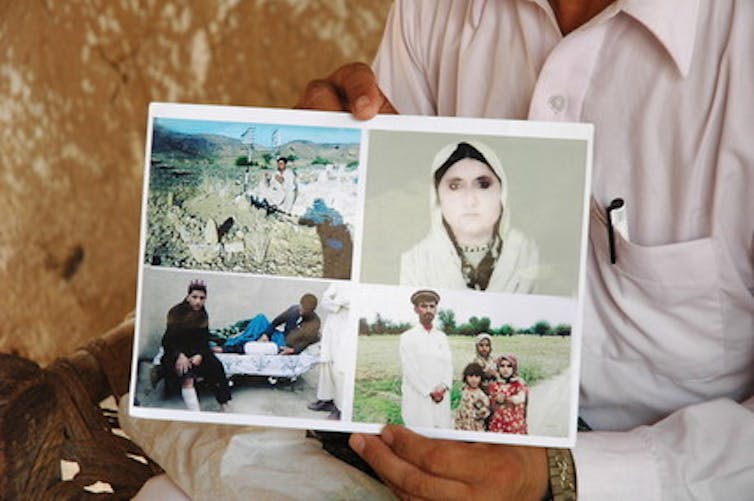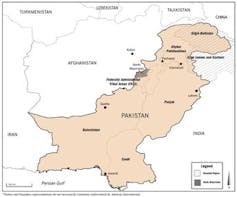
Pakistani prime minister Nawaz Sharif will meet with US president Barack Obama tomorrow, and American drone attacks are likely to be high on the agenda, alongside the impact of developments in Afghanistan, including the withdrawal of NATO’s International Security Assistance Force by the end of next year.
Likely demands by Pakistan for a further scaling down of the use of drones have received substantial support in two recent reports. Released September, the first of them is the interim report to the UN General Assembly on the use of remotely piloted aircraft in counter-terrorism operations by Ben Emmerson, the secretary general’s special rapporteur.
Amnesty International’s report, released this morning, covers similar ground, with a specific focus on Pakistan and the effect that the US drones campaign in North Waziristan has had on the civilian population there.
Balanced perspectives
Much to the credit of the respective authors, neither report offers a blanket condemnation of the use of drones. Both lament the legal ambiguity and controversy that surrounds the deployment of drones in counter-terrorist and counter-insurgency campaigns. This complaint is echoed in the report of the special rapporteur on extrajudicial, summary or arbitrary executions, Christoph Heyns.

The authors of these reports all concur that it is the secrecy and complete lack of transparency, especially on the part of the US government, which seriously harms the prospects of a well-informed and balanced public debate on the issue.
Based on data in the public domain and information gained in the course of researching the reports, both Emmerson and Amnesty International acknowledge that the US drones campaign in Pakistan and elsewhere has contributed to degrading terrorist and insurgent capabilities and networks. Emmerson concludes:
If used in strict compliance with the principles of international humanitarian law, remotely piloted aircraft are capable of reducing the risk of civilian casualties in armed conflict by significantly improving the situational awareness of military commanders.
Civilian suffering
Amnesty International additionally offers well-researched evidence that civilians’ lives have been put at great risk in Pakistan’s North Waziristan as a consequence of the increased use of signature strikes, which target people who “match a pre-identified ‘signature’ of behaviour” associated with militant activity, rather than targeting pre-identified individuals. Secondary strikes - or “double taps” - which are made within minutes of the first strike when people rush to the scene to help potential survivors, put civilians further at risk.
Perhaps the most powerful point that Amnesty International makes in its report is that civilians in North Waziristan do not merely suffer from the material and psychological effects of the constant presence of drones. What is more pervasive is the sense of being helplessly caught between the three fronts of insurgent activity, government repression and collusion and US drone warfare.

By all accounts, civilian casualties have declined over time in absolute numbers and relative to the number of insurgents and terrorists killed, but this does not diminish the civilian suffering caused, nor does it absolve Pakistan, the US or the various Taliban and al-Qaeda affiliated groups.
Changes to drones policy
As drone technology and use proliferate, so will counter-measures. Drones (and those using them) will not always enjoy the lack of serious threats to their operation they currently do. There is already some evidence of al-Qaeda and affiliated groups changing their behaviour to make them less susceptible to signature strikes and developing jamming capabilities to disrupt the operation of drones.
Similarly, there appears to be a shift in US drone use - the overall number of strikes in 2013 is lower so far than in previous years. In addition recent high-profile attempts to capture, rather than kill, high-value targets in Libya and Somalia also suggest a partial re-orientation of counter-terrorist efforts. Meanwhile recent remarks by NATO Secretary General Anders Fogh Rasmussen, urging European NATO members “to acquire more drones to improve surveillance” imply a similar shift in orientation.
Toward a drones strategy?
Yet, re-orientation should not be mistaken for abandoning the use of drones for varied purposes (including intelligence gathering and targeted strikes) as part of a wider national and international security strategy pursued by the US and its partners (as well as by potential rivals and adversaries).
This is partly due to the fact that drones have been effective. When the Pakistani Taliban offered to enter into negotiations with the government over a political settlement, an end to US drone strikes was one one of their demands.
A recent study carried out at the US Army War College notes that drones are more likely to be effective in pursuit of counter-terrorist objectives and consequently that their use for counter-insurgency purposes will not produce significant or lasting gains.
It is in this light, too, that we should assess the significance of the recently apparent shifts in US drones strategy noted above, as well as the fact that a repeat of the heavy deployment of drones in Iraq in 2005-06 is not on the horizon despite the growing violence there.
Drones are here to stay as part of military arsenals and as tools for various objectives pursued by an increasing number of state and non-state actors. As illustrated by Emmerson’s and Amensty International’s reports, a better informed and more balanced debate about drones is beginning to emerge.
That the debate about drone use is becoming more mature is also evident in contributions by academics and think-tanks like the International Crisis Group. There is also evidence of greater interest by policymakers, including in the United Kingdom, in this issue. Those policymakers are increasingly open to academic input - as shown by the recently launched Policy Commission on the security impact of drones, chaired by Sir David Omand, the UK’s former security and intelligence co-ordinator and director of GCHQ.
The debate on drones needs to remain open to different perspectives, to promote constructive engagement between opponents and advocates of drones and to be afforded more openness and transparency from governments. Only then can it credibly contribute to the further evolution of an actual drones strategy which is more than a stop-gap measure to fill an existing grand strategy void in dealing with contemporary international security challenges.
